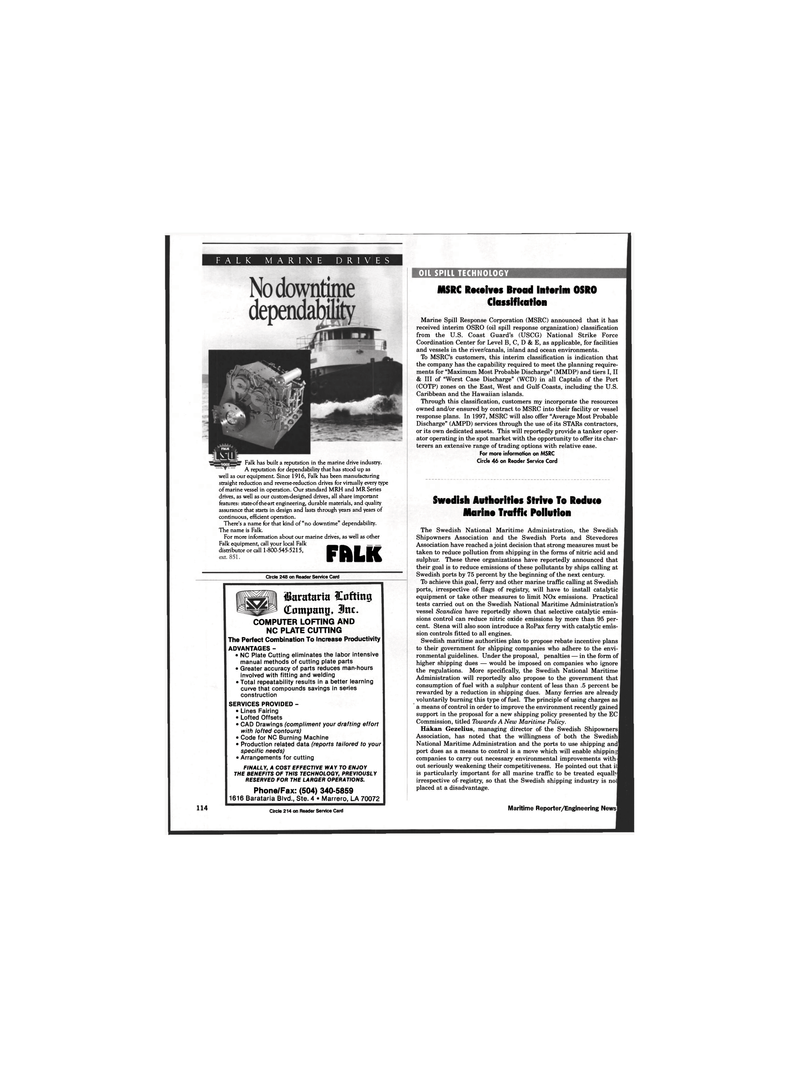
Page 112: of Maritime Reporter Magazine (November 1996)
Read this page in Pdf, Flash or Html5 edition of November 1996 Maritime Reporter Magazine
FALK MARINE DRIVES
Falk has built a reputation in the marine drive industry.
A reputation for dependability that has stood up as well as our equipment. Since 1916, Falk has been manufacturing straight reduction and reverse-reduction drives for virtually every type of marine vessel in operation. Our standard MRH and MR Series drives, as well as our custom-designed drives, all share important features: state-of-the-art engineering, durable materials, and quality assurance that starts in design and lasts through years and years of continuous, efficient operation.
There's a name for that kind of "no downtime" dependability.
The name is Falk.
For more information about our marine drives, as well as other
Falk equipment, call your local Falk ^^^^ distributor or call 1-800-545-5215, V^kB WW rHhll
Circle 248 on Reader Service Card iBarataria Cnfting (Company, 3nc.
COMPUTER LOFTING AND
NC PLATE CUTTING
The Perfect Combination To Increase Productivity
ADVANTAGES - • NC Plate Cutting eliminates the labor intensive manual methods of cutting plate parts • Greater accuracy of parts reduces man-hours involved with fitting and welding • Total repeatability results in a better learning curve that compounds savings in series construction
SERVICES PROVIDED - • Lines Fairing • Lofted Offsets • CAD Drawings (compliment your drafting effort with lofted contours) • Code for NC Burning Machine • Production related data (reports tailored to your specific needs) • Arrangements for cutting
FINALLY, A COST EFFECTIVE WAY TO ENJOY
THE BENEFITS OF THIS TECHNOLOGY, PREVIOUSLY
RESERVED FOR THE LARGER OPERATIONS.
Phone/Fax: (504) 340-5859 1616 Barataria Blvd., Ste. 4 • Marrero, LA 70072
OIL SPILL TECHNOLOGY
MSRC Receives Broad Interim OSRO
Classification
Marine Spill Response Corporation (MSRC) announced that it has received interim OSRO (oil spill response organization) classification from the U.S. Coast Guard's (USCG) National Strike Force
Coordination Center for Level B, C, D & E, as applicable, for facilities and vessels in the river/canals, inland and ocean environments.
To MSRC's customers, this interim classification is indication that the company has the capability required to meet the planning require- ments for "Maximum Most Probable Discharge" (MMDP) and tiers I, II & III of "Worst Case Discharge" (WCD) in all Captain of the Port (COTP) zones on the East, West and Gulf Coasts, including the U.S.
Caribbean and the Hawaiian islands.
Through this classification, customers my incorporate the resources owned and/or ensured by contract to MSRC into their facility or vessel response plans. In 1997, MSRC will also offer "Average Most Probable
Discharge" (AMPD) services through the use of its STARs contractors, or its own dedicated assets. This will reportedly provide a tanker oper- ator operating in the spot market with the opportunity to offer its char- terers an extensive range of trading options with relative ease.
For more information on MSRC
Circle 46 on Reader Service Card
Swedish Authorities Strive To Reduce
Marine Traffic Pollution
The Swedish National Maritime Administration, the Swedish
Shipowners Association and the Swedish Ports and Stevedores
Association have reached a joint decision that strong measures must be taken to reduce pollution from shipping in the forms of nitric acid and sulphur. These three organizations have reportedly announced that their goal is to reduce emissions of these pollutants by ships calling at
Swedish ports by 75 percent by the beginning of the next century.
To achieve this goal, ferry and other marine traffic calling at Swedish ports, irrespective of flags of registry, will have to install catalytic equipment or take other measures to limit NOx emissions. Practical tests carried out on the Swedish National Maritime Administration's vessel Scandica have reportedly shown that selective catalytic emis- sions control can reduce nitric oxide emissions by more than 95 per- cent. Stena will also soon introduce a RoPax ferry with catalytic emis- sion controls fitted to all engines.
Swedish maritime authorities plan to propose rebate incentive plans to their government for shipping companies who adhere to the envi- ronmental guidelines. Under the proposal, penalties — in the form of higher shipping dues — would be imposed on companies who ignore the regulations. More specifically, the Swedish National Maritime
Administration will reportedly also propose to the government that consumption of fuel with a sulphur content of less than .5 percent be rewarded by a reduction in shipping dues. Many ferries are already voluntarily burning this type of fuel. The principle of using charges as a means of control in order to improve the environment recently gained support in the proposal for a new shipping policy presented by the EC
Commission, titled Towards A New Maritime Policy.
Hakan Gezelius, managing director of the Swedish Shipowners
Association, has noted that the willingness of both the Swedish
National Maritime Administration and the ports to use shipping and port dues as a means to control is a move which will enable shippin companies to carry out necessary environmental improvements with out seriously weakening their competitiveness. He pointed out that i is particularly important for all marine traffic to be treated equall; irrespective of registry, so that the Swedish shipping industry is no placed at a disadvantage. 114 Circle 214 on Reader Service Card Maritime Reporter/Engineering News

 111
111

 113
113
